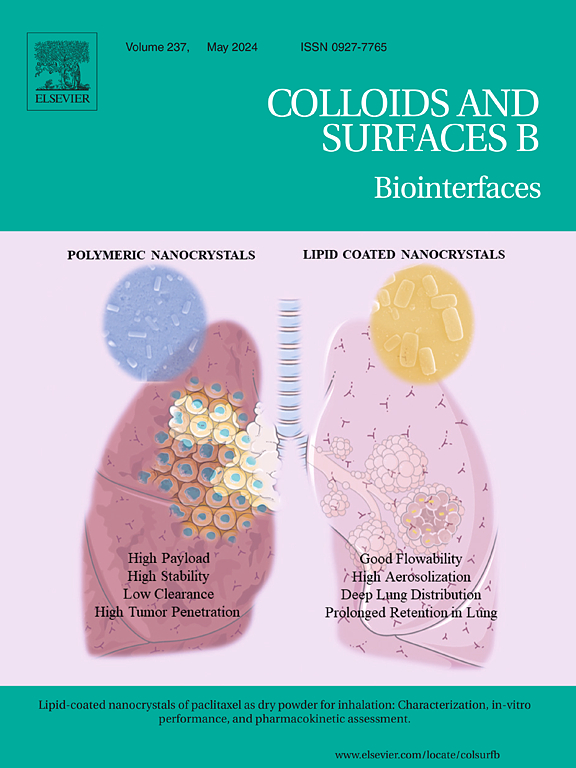Characterization of the surface charge and reactivity of Schizophyllum commune mycelium material
IF 5.4
2区 医学
Q1 BIOPHYSICS
引用次数: 0
Abstract
Mycelium fabrics are an emerging alternative to textiles and leather. Here we studied surface charge and reactivity of water-washed and KOH-treated mycelium and water-extracted and KOH-extracted cell walls from Schizophyllum commune. Zeta potential analysis was used to study the surface charge of the mycelium, while FTIR, amino acid analysis and isoelectric point shift were used to assess functional group accessibility and reactivity of the cross-linker glutaraldehyde. The isoelectric point (pI) of water-washed and KOH-treated mycelium was found at pH 2.75 and pH 3.58, respectively, and at pH 3.55 for KOH-extracted cell walls. No pI was found for water-extracted cell walls in a pH range of 2–9. Treatment of water-washed mycelium and water-extracted cell walls with glutaraldehyde resulted in a pI shift from pH 2.75 to pH 3.07 and from no pI in the range of 2–9 to a pI of 2.72, suggesting binding to acid groups. By contrast, a pI shift to lower pH (from pH 3.58 and 3.55 to pH 2.77 and 3.17, respectively) was observed after treatment of KOH-washed mycelium and KOH-extracted cell walls with glutaraldehyde, indicating binding to basic groups. Indeed, amino acid analysis showed a reduction in lysine after treatment with the cross-linker. Together, results indicate that a higher incidence of cross-linking of glutaraldehyde to polysaccharides is responsible for the pI shift to higher pH in the case of the water-treated mycelium, while a higher incidence of binding to basic amino acids causes the shift to lower pH in the case of KOH-treated mycelium and KOH-extracted cell walls.
裂叶菌菌丝材料表面电荷和反应性的表征
菌丝织物是一种新兴的纺织品和皮革替代品。本文研究了裂藻水洗和氢氧化钾处理菌丝体以及水提和氢氧化钾提取细胞壁的表面电荷和反应性。利用Zeta电位分析研究菌丝的表面电荷,利用FTIR、氨基酸分析和等电点位移评价交联剂戊二醛的官能团可及性和反应性。水洗菌丝和氢氧化钾处理菌丝的等电点(pI)分别为pH 2.75和pH 3.58,氢氧化钾提取细胞壁的等电点为pH 3.55。在2-9的pH范围内,水提细胞壁未发现pI。用戊二醛处理水洗菌丝体和水提细胞壁时,其pI值从pH 2.75变为pH 3.07,从2-9范围内的无pI变为pI 2.72,表明其与酸性基团结合。相比之下,用戊二醛处理koh洗过的菌丝体和koh提取的细胞壁后,pH值从3.58和3.55下降到2.77和3.17,表明与碱性基团结合。事实上,氨基酸分析显示,用交联剂处理后赖氨酸减少。总之,结果表明,在水处理的菌丝体中,戊二醛与多糖交联的发生率较高,导致pI向更高的pH值移动,而在koh处理的菌丝体和koh提取的细胞壁中,与碱性氨基酸结合的发生率较高,导致pI向更低的pH值移动。
本文章由计算机程序翻译,如有差异,请以英文原文为准。
求助全文
约1分钟内获得全文
求助全文
来源期刊

Colloids and Surfaces B: Biointerfaces
生物-材料科学:生物材料
CiteScore
11.10
自引率
3.40%
发文量
730
审稿时长
42 days
期刊介绍:
Colloids and Surfaces B: Biointerfaces is an international journal devoted to fundamental and applied research on colloid and interfacial phenomena in relation to systems of biological origin, having particular relevance to the medical, pharmaceutical, biotechnological, food and cosmetic fields.
Submissions that: (1) deal solely with biological phenomena and do not describe the physico-chemical or colloid-chemical background and/or mechanism of the phenomena, and (2) deal solely with colloid/interfacial phenomena and do not have appropriate biological content or relevance, are outside the scope of the journal and will not be considered for publication.
The journal publishes regular research papers, reviews, short communications and invited perspective articles, called BioInterface Perspectives. The BioInterface Perspective provide researchers the opportunity to review their own work, as well as provide insight into the work of others that inspired and influenced the author. Regular articles should have a maximum total length of 6,000 words. In addition, a (combined) maximum of 8 normal-sized figures and/or tables is allowed (so for instance 3 tables and 5 figures). For multiple-panel figures each set of two panels equates to one figure. Short communications should not exceed half of the above. It is required to give on the article cover page a short statistical summary of the article listing the total number of words and tables/figures.
 求助内容:
求助内容: 应助结果提醒方式:
应助结果提醒方式:


